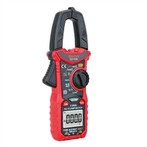Fault Diagnosis Method for Multimeter
1. Observation method
Utilize visual, olfactory, and tactile senses. Sometimes, damaged components may discolor, blister, or show burnt spots; Burnt out devices may produce some special odors; Short circuited chips can burn; False soldering or detachment can also be observed with the naked eye.
2. Knocking hand pressure method
It is common to encounter the phenomenon of instruments running good and bad, which is mostly caused by poor contact or faulty soldering. For this situation, tapping and hand pressing methods can be used.
The so-called "knocking" refers to gently tapping the plug-in board or component with a small rubber hammer or other knocking object to see if it will cause an error or shutdown fault at the location where the fault may occur.
The so-called "hand pressing" refers to when a malfunction occurs, turning off the power and re pressing the inserted components, plugs, and seats firmly with hands, and then turning on the machine to see if it will eliminate the malfunction. If it is found that knocking the casing is normal, but knocking it again is not normal, it is best to reinsert all the connectors first and try again. If the problem is not successful, we have to find another way.
3. Exclusion method
The so-called troubleshooting method is to determine the cause of a malfunction by plugging and unplugging some plug-in boards and devices inside the machine. When a certain plug-in board or device is unplugged and the instrument returns to normal, it indicates where the fault occurred.
4. Substitution method
Two instruments of the same model or sufficient spare parts are required. Replace a good spare part with the same component on the faulty machine to see if the fault has been eliminated.
5. Comparative method
Two instruments of the same model are required, and one of them is functioning normally. To use this method, it is necessary to have necessary equipment, such as a multimeter, oscilloscope, etc. According to the nature of comparison, there are voltage comparison, waveform comparison, static impedance comparison, output result comparison, current comparison, etc.
Specific method: Let the faulty instrument and the normal instrument operate under the same conditions, then detect signals at some points and compare the two sets of signals measured. If there are differences, it can be concluded that the fault is here. This method requires maintenance personnel to have considerable knowledge and skills. Fault diagnosis methods for instruments and meters such as multimeter
6. Ascending and descending temperature method
Sometimes the instrument works for a long time, or when the working environment temperature is high in summer, it will malfunction. The shutdown check is normal, and after stopping for a period of time, the power on is normal again. After a while, the malfunction will occur again. This phenomenon is caused by the poor performance of individual ICs or components, and the inability of high-temperature characteristic parameters to meet the indicator requirements. To identify the cause of the malfunction, the temperature rise and fall method can be used.
Cooling down refers to wiping anhydrous alcohol onto the area where a malfunction may occur with cotton fibers to cool it down and observe whether the malfunction has been eliminated. Heating up refers to artificially raising the ambient temperature, such as placing an electric soldering iron close to a suspected area (be careful not to raise the temperature too high to damage normal devices) to see if a malfunction has occurred.
7. Shoulder riding technique
Shoulder riding method, also known as parallel connection method. Install a good IC chip on top of the chip to be inspected, or connect good components (resistors, capacitors, diodes, transistors, etc.) in parallel with the component to be inspected, maintaining good contact. If the fault is caused by an internal open circuit or poor contact within the device, this method can be used to eliminate it.
8. Capacitance bypass method
When a certain circuit experiences strange phenomena, such as display confusion, the capacitor bypass method can be used to determine the likely faulty part of the circuit. Connect the capacitor across the power and ground terminals of the IC; Cross connect the transistor circuit at the base input terminal or collector output terminal, and observe the impact on the fault phenomenon. If the capacitor bypass input terminal is invalid and the fault phenomenon disappears when bypassing its output terminal, it is determined that the fault occurs in this level of circuit.
9. State adjustment method
Generally speaking, before the fault is determined, do not touch any components in the circuit, especially adjustable devices such as potentiometers. However, if multiple reference measures are taken in advance (such as marking the position or measuring the voltage or resistance value before touching), it is still allowed to touch if necessary. Perhaps after the change, sometimes the malfunction will be eliminated.
10. Isolation method
The fault isolation method does not require comparison of equipment or spare parts of the same model, and is safe and reliable. According to the fault detection flow chart, the fault search scope is gradually reduced by dividing and surrounding, and then combined with signal comparison, component exchange and other methods, the fault will generally be found quickly.










